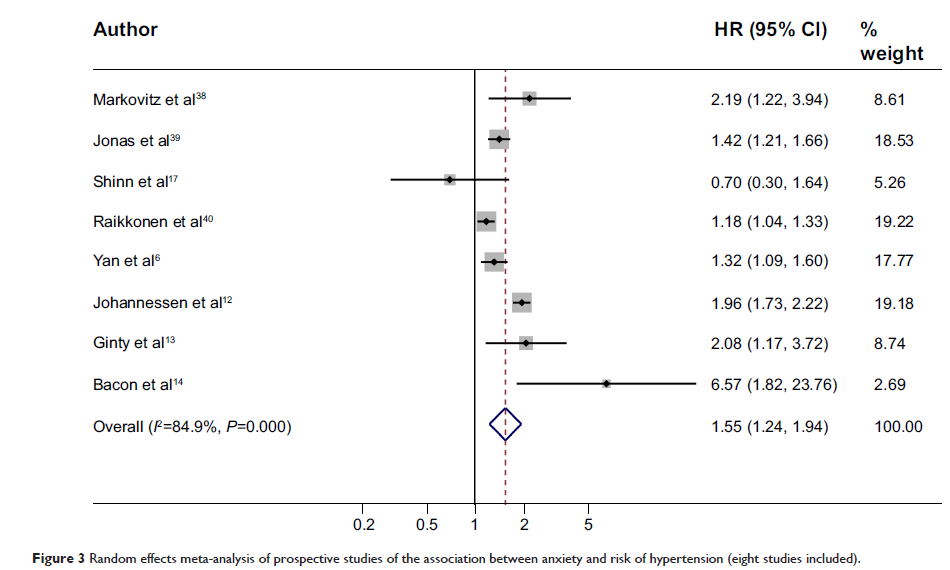9 7 4 9 1
论文已发表
注册即可获取德孚的最新动态
IF 收录期刊
- 3.3 Breast Cancer (Dove Med Press)
- 3.4 Clin Epidemiol
- 2.5 Cancer Manag Res
- 2.9 Infect Drug Resist
- 3.5 Clin Interv Aging
- 4.7 Drug Des Dev Ther
- 2.7 Int J Chronic Obstr
- 6.6 Int J Nanomed
- 2.5 Int J Women's Health
- 2.5 Neuropsych Dis Treat
- 2.7 OncoTargets Ther
- 2.0 Patient Prefer Adher
- 2.3 Ther Clin Risk Manag
- 2.5 J Pain Res
- 2.8 Diabet Metab Synd Ob
- 2.8 Psychol Res Behav Ma
- 3.0 Nat Sci Sleep
- 1.8 Pharmgenomics Pers Med
- 2.7 Risk Manag Healthc Policy
- 4.2 J Inflamm Res
- 2.1 Int J Gen Med
- 4.2 J Hepatocell Carcinoma
- 3.7 J Asthma Allergy
- 1.9 Clin Cosmet Investig Dermatol
- 2.7 J Multidiscip Healthc

焦虑与高血压之间的关联: 对流行病学研究的一个系统性回顾和综合分析
Authors Pan Y, Cai W, Cheng Q, Dong W, An T, Yan J
Published Date April 2015 Volume 2015:11 Pages 1121—1130
DOI http://dx.doi.org/10.2147/NDT.S77710
Received 18 November 2014, Accepted 15 January 2015, Published 22 April 2015
Background: Epidemiological studies have repeatedly investigated the association between
anxiety and hypertension. However, the results have been inconsistent. This
study aimed to summarize the current evidence from cross-sectional and prospective
studies that evaluated this association.
Methods: Seven common databases
were searched for articles published up to November 2014. Cross-sectional and
prospective studies that reported an association between the two conditions in
adults were included. Data on prevalence, incidence, unadjusted or adjusted
odds ratios or hazard ratios, and 95% confidence intervals (CIs) were extracted
or calculated by the authors. The pooled odds ratio was calculated separately
for cross-sectional and prospective studies using random-effects models. The Q test and I 2 statistic was used to
assess heterogeneity. A funnel plot and modified Egger linear regression test
were used to estimate publication bias.
Results: The search yielded 13
cross-sectional studies (n=151,389), and the final pooled odds ratio was 1.18
(95% CI 1.02–1.37; P Q<0.001; I 2=84.9%). Eight
prospective studies with a total sample size of 80,146 and 2,394 hypertension
case subjects, and the pooled adjusted hazard ratio was 1.55 (95% CI 1.24–1.94; P Q<0.001; I 2=84.6%). The
meta-regression showed that location, diagnostic criteria for anxiety, age,
sex, sample size, year of publication, quality, and years of follow-up (for
prospective study) were not sources of heterogeneity.
Conclusion: Our results suggest
that there is an association between anxiety and increased risk of
hypertension. These results support early detection and management of anxiety
in hypertensive patients.
Keywords: human, epidemiological
association, anxiety disorder, hypertension, meta-analysis
